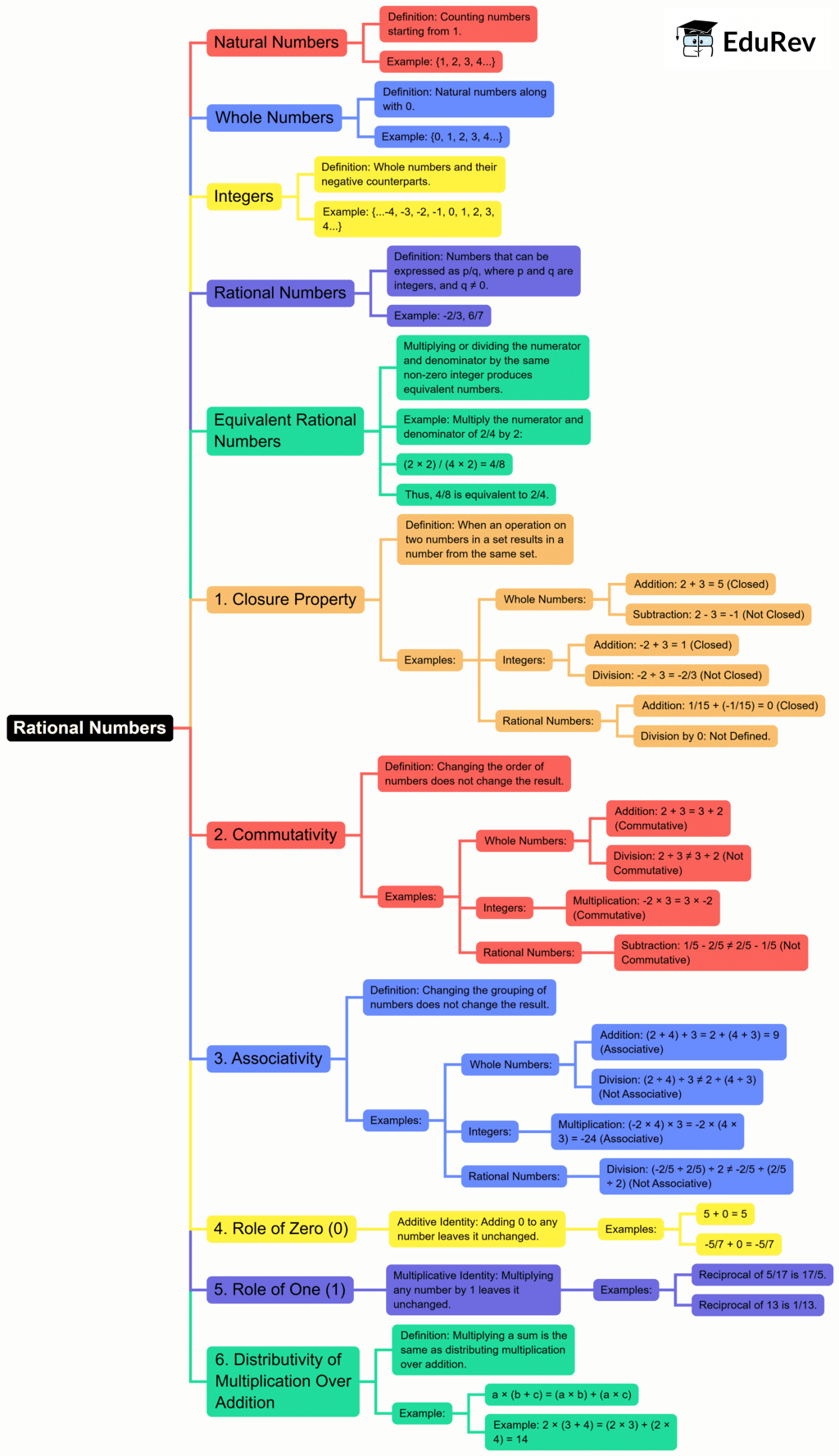Class 8 Exam > Class 8 Notes > Mathematics (Maths) Class 8 > Mind Map: Rational Numbers
Mind Map: Rational Numbers | Mathematics (Maths) Class 8 PDF Download

The document Mind Map: Rational Numbers | Mathematics (Maths) Class 8 is a part of the Class 8 Course Mathematics (Maths) Class 8.
All you need of Class 8 at this link: Class 8
|
81 videos|423 docs|31 tests
|
FAQs on Mind Map: Rational Numbers - Mathematics (Maths) Class 8
| 1. What are rational numbers, and how are they different from integers and whole numbers? |  |
Ans. Rational numbers are numbers that can be expressed as a fraction p/q, where p and q are integers, and q is not equal to zero. They include integers (which are whole numbers that can be positive, negative, or zero) as well as fractions. Whole numbers are a subset of rational numbers that include all non-negative integers (0, 1, 2, ...). Thus, while all integers and whole numbers are rational numbers, not all rational numbers are integers or whole numbers.
| 2. How do you convert a repeating decimal into a rational number? |  |
Ans. To convert a repeating decimal into a rational number, let x be the repeating decimal. For example, if x = 0.666... (where 6 repeats), multiply both sides by 10 (to shift the decimal point) to get 10x = 6. Then, subtract the original equation from this new equation: 10x - x = 6, which simplifies to 9x = 6. Dividing both sides by 9 gives x = 6/9, which can be simplified to 2/3. Thus, 0.666... = 2/3 as a rational number.
| 3. What is the significance of the term "like" and "unlike" fractions in rational numbers? |  |
Ans. "Like fractions" are fractions that have the same denominator, making them easy to compare and perform arithmetic operations like addition and subtraction. For example, 1/4 and 3/4 are like fractions. "Unlike fractions," on the other hand, have different denominators, which require finding a common denominator before performing operations. For instance, to add 1/3 and 1/4, you would first convert them to like fractions (common denominator of 12) to get 4/12 + 3/12 = 7/12.
| 4. How do you perform operations such as addition and subtraction on rational numbers? |  |
Ans. To add or subtract rational numbers, first ensure they have a common denominator. For instance, to add 1/3 and 1/4, find a common denominator (12), converting the fractions to 4/12 and 3/12, respectively. Then, add the numerators: 4 + 3 = 7, resulting in 7/12. For subtraction, the process is the same, but you subtract the numerators instead. So, 5/6 - 1/3 would require converting 1/3 to 2/6, yielding 5/6 - 2/6 = 3/6, which simplifies to 1/2.
| 5. What are some real-life examples of rational numbers? |  |
Ans. Rational numbers are prevalent in everyday life. For example, when measuring ingredients in cooking, such as 1/2 cup of sugar or 3/4 teaspoon of salt, these quantities are rational numbers. Similarly, when dealing with money, prices such as $4.50 or $2.75 represent rational numbers as they can be expressed as fractions (9/2 and 11/4, respectively). Additionally, in sports, scores and statistics often involve rational numbers, like a batting average of 0.250 or a completion percentage of 75/100.
Related Searches






















